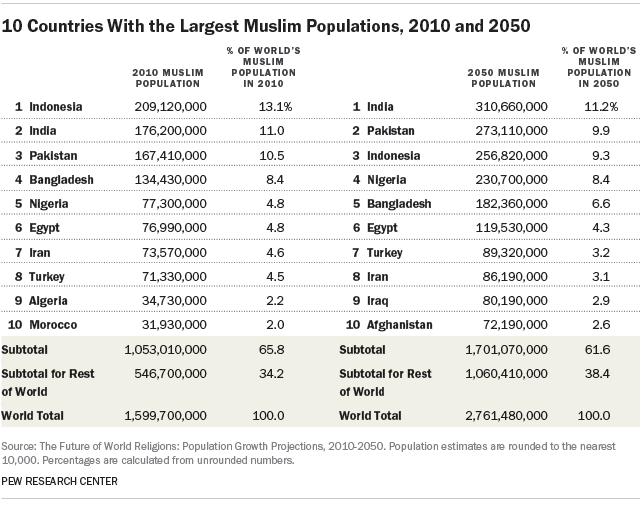India will have world’s largest Muslim population by 2050
India will have world’s largest Muslim population by 2050

NEW DELHI (INDIA): The number of Muslims around the world is projected to increase rapidly in the decades ahead, growing from about 1.6 billion in 2010 to nearly 2.8 billion in 2050, according to pewforum report.nn40 Muslims are expected to grow twice as fast as the overall global population. Consequently, Muslims are projected to rise from 23% of the world?s population in 2010 to 30% in 2050.nnThis significant projected growth is largely due to the young age and high fertility rate of Muslims relative to other religious groups.nnThe annual growth rate of Muslims is expected to be considerably higher than the rate for the world as a whole. In 2010-2015, the expected Muslim growth rate is 1.8% while the rate for the world?s population is 1.1%. Both rates are expected to decline over time. In 2045-2050, for example, the annual growth rate of Muslims is projected to be about 1% while it will be 0.4% for the world.nnRegional ChangennLooking to the future, the Asia-Pacific region is expected to remain the home of a majority of the world?s Muslims. However, the share of the global Muslim population living in several Asian countries with large Muslim populations (such as Indonesia, Pakistan and Bangladesh) is anticipated to decline between 2010 and 2050. While 62% of the world?s Muslims lived in Asia and the Pacific in 2010, 53% are projected to live in the region in 2050.nnThe Middle East-North Africa region is predominantly Muslim, but as of 2010, only one-in-five Muslims lived in that part of the world. By 2050, about the same share of the global Muslim population is expected to live in the Middle East and North Africa (20%).nnSub-Saharan Africa is projected to have a significantly larger share of the world?s Muslims in 2050 compared with 2010. About 24% of the world?s Muslims are expected to live in sub-Saharan Africa in 2050, up from nearly 16% in 2010.nnMuslim populations are expected to grow in absolute number in all regions of the world between 2010 and 2050. In the Asia-Pacific region, for instance, the Muslim population is expected to reach nearly 1.5 billion by 2050, up from roughly 1 billion in 2010. The number of Muslims in the Middle East-North Africa region is expected to increase from about 300 million in 2010 to more than 550 million in 2050. The Muslim population in sub-Saharan Africa is forecast to more than double, growing from about 250 million in 2010 to nearly 670 million in 2050. The absolute number of Muslims also is projected to increase in regions with smaller Muslim populations, including Europe and North America.nnAlthough a smaller share of the world?s Muslims are projected to live in the Asia-Pacific region in 2050 compared with 2010, the share of the region?s population that is Muslim is expected to grow from 24% in 2010 to nearly 30% in 2050. In fact, Muslims are projected to surpass Hindus and become the largest religious group in the Asia-Pacific region by 2050.nnThe share of the population in sub-Saharan Africa that is Muslim also is expected to grow in the coming decades, from about 30% in 2010 to 35% in 2050. Meanwhile, the overwhelming majority of the population in the Middle East and North Africa is projected to remain Muslim ? increasing from about 93% of the region?s population in 2010 to 94% in 2050.nnAs a share of Europe?s population, Muslims are expected to nearly double, growing from about 6% in 2010 to about 10% in 2050. In North America, the share of the population identifying with Islam is expected to grow from 1% to 2% in the coming decades.nnBetween 2010 and 2050, the most rapid Muslim population growth in percentage terms is projected to occur in North America (197%) ? more than seven times the expected increase in the region?s overall population (26%). The Muslim population in sub-Saharan Africa also is anticipated to grow more than in the region as a whole (170% vs. 131%).nnWith the bulk of the Middle East-North Africa region?s population being Muslim, the overall growth for Muslims there (74%) is expected to be about the same as the region overall (73%).nnThe Muslim population in Europe is expected to grow by 63% between 2010 and 2050, while Europe?s overall population is expected to decrease in size (minus 6%). During this period, the Muslim population in the Asia-Pacific region is expected to increase by 48% while the region?s population as a whole increases by 22%.nnThe relatively small population of Muslims in Latin America and the Caribbean is anticipated to increase by 13% between 2010 and 2050, while the region?s overall population is expected to grow 27%.nnChange in Countries With Largest Muslim PopulationsnnCollectively, the 10 countries with the largest Muslim populations in 2010 are expected to account for roughly the same share of the world?s total population in coming decades (35% in 2050, compared with about 32% in 2010). In most cases, little change is expected in each country?s share of the global population. The one exception is Nigeria, where about 4% of the world?s population is expected to reside in 2050 (up from about 2% in 2010).nnIn eight of the 10 countries, the share of the population that is Muslim is expected to remain about the same. However, the Muslim share of the population is expected to increase in India and Nigeria. Muslims made up 14% of India?s population in 2010; they are expected to rise to 18% in 2050. Less than half of Nigeria?s population (49%) was Muslim in 2010, but Muslims are expected to make up a majority of the population (59%) in 2050.nnAs of 2010, Indonesia had the largest number of Muslims (about 209 million Muslims, or about 13% of the world?s Muslims), followed by India (176 million, or about 11%), Pakistan (167 million, 10%) and Bangladesh (134 million, 8%). Nigeria, Egypt, Iran and Turkey each also had more than 70 million Muslims in 2010.nnWith the exception of India, where Muslims are a minority religious group, and Nigeria, where Muslims made up nearly half the population, the other eight countries on the list each had a large Muslim majority in 2010.nnIndia is projected to have the world?s largest Muslim population in 2050 (311 million), while Pakistan is expected to have the second-most Muslims (273 million). Indonesia ? the country with the largest number of Muslims in 2010 ? is expected to fall to third place by 2050, with 257 million Muslims. Nigeria is forecast to rank fourth, with about 231 million Muslims at mid-century.nnBy 2050, Iraq and Afghanistan are expected to join the list of countries with the 10 largest Muslim populations. All told, more than six-in-ten of the world?s Muslims (62%) are projected to live in the 10 countries with the most Muslims in 2050, slightly smaller than the share of the world?s Muslims that lived in the top 10 countries in 2010 (66%).






